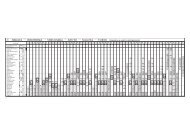CENTRAL JAPAN RAILWAY COMPANY Annual Report 2007
CENTRAL JAPAN RAILWAY COMPANY Annual Report 2007
CENTRAL JAPAN RAILWAY COMPANY Annual Report 2007
You also want an ePaper? Increase the reach of your titles
YUMPU automatically turns print PDFs into web optimized ePapers that Google loves.
8. LONG-TERM PAYABLES<br />
Long-term payables as of March 31, <strong>2007</strong> and 2006, consisted of the following:<br />
<br />
<br />
<br />
<br />
<br />
<br />
<br />
Total<br />
<br />
Long-term payables, less current maturities<br />
<br />
<br />
<br />
<strong>2007</strong> 2006 <strong>2007</strong><br />
¥ 1,390,380<br />
224,711<br />
579,157<br />
9,821<br />
2,204,071<br />
(116,697)<br />
¥ 2,087,373<br />
¥ 1,574,031<br />
290,726<br />
581,335<br />
10,122<br />
2,456,215<br />
(186,336)<br />
¥ 2,269,879<br />
$ 11,782,881<br />
1,904,330<br />
4,908,110<br />
83,237<br />
18,678,558<br />
(988,957)<br />
$ 17,689,601<br />
Based on debt assumption agreements with financial institutions and a special purpose entity, the Company has transferred the debt repayment obligation for<br />
certain long-term payables to such financial institutions and special purpose entity and has provided such financial institutions and special purpose entity with<br />
Japanese national government bonds or cash for the payment of principal and interest on the long-term payables. As a result of such transactions, the balance<br />
of long-term payables derecognized amounted to ¥386,083 million ($3,271,889 thousand) and ¥362,686 million as of March 31, <strong>2007</strong> and 2006, respectively,<br />
and the related loss on debt assumption amounted to ¥23,465 million ($198,855 thousand) and ¥33,507million for the years ended March 31, <strong>2007</strong>and 2006,<br />
respectively (see Note 12).<br />
The annual maturities of long-term payables as of March 31, <strong>2007</strong>, were as follows:<br />
<br />
<br />
<br />
<br />
<br />
<br />
<br />
Total<br />
<br />
¥ 116,697<br />
121,843<br />
127,469<br />
133,137<br />
138,817<br />
1,566,106<br />
¥ 2,204,071<br />
<br />
<br />
$ 988,957<br />
1,032,567<br />
1,080,245<br />
1,128,279<br />
1,176,415<br />
13,272,095<br />
$ 18,678,558<br />
Interest expense on the aforementioned long-term payables amounted to ¥121,525 million ($1,029,872 thousand), ¥135,154 million and ¥152,338 million for<br />
the years ended March 31, <strong>2007</strong>, 2006 and 2005, respectively.<br />
9. EQUITY<br />
On and after May 1, 2006, Japanese companies are subject to a new corporate law of Japan (the "Corporate Law") , which reformed and replaced the<br />
Commercial Code of Japan with various revisions that are, for the most part, applicable to events or transactions which occur on or after May 1, 2006 and for<br />
the fiscal years ending on or after May 1, 2006. The significant changes in the Corporate Law that affect financial and accounting matters are summarized<br />
below;<br />
a. Dividends<br />
Under the Corporate Law, companies can pay dividends at any time during the fiscal year in addition to the year-end dividend upon resolution at the<br />
shareholders meeting. For companies that meet certain criteria such as: (1) having the Board of Directors, (2) having independent auditors, (3) having the<br />
Board of Corporate Auditors, and (4) the term of service of the directors is prescribed as one year rather than two years of normal term by its articles of<br />
incorporation, the Board of Directors may declare dividends (except for dividends in kind) at any time during the fiscal year if the company has prescribed so<br />
in its articles of incorporation.<br />
The Corporate Law permits companies to distribute dividends-in-kind (non-cash assets) to shareholders subject to a certain limitation and additional<br />
requirements.<br />
Semiannual interim dividends may also be paid once a year upon resolution by the Board of Directors if the articles of incorporation of the company so<br />
stipulate. The Corporate Law provides certain limitations on the amounts available for dividends or the purchase of treasury stock. The limitation is defined<br />
as the amount available for distribution to the shareholders, but the amount of net assets after dividends must be maintained at no less than ¥3 million.<br />
b. Increases/Decreases and Transfer of Common Stock, Reserve and Surplus<br />
The Corporate Law requires that an amount equal to 10% of dividends must be appropriated as a legal reserve (a component of retained earnings) or as<br />
additional paid-in capital (a component of capital surplus) depending on the equity account charged upon the payment of such dividends until the total of<br />
aggregate amount of legal reserve and additional paid-in capital equals 25% of the common stock. Under the Corporate Law, the total amount of additional<br />
paid-in capital and legal reserve may be reversed without limitation. The Corporate Law also provides that common stock, legal reserve, additional paid-in<br />
capital, other capital surplus and retained earnings can be transferred among the accounts under certain conditions upon resolution of the shareholders.<br />
58





